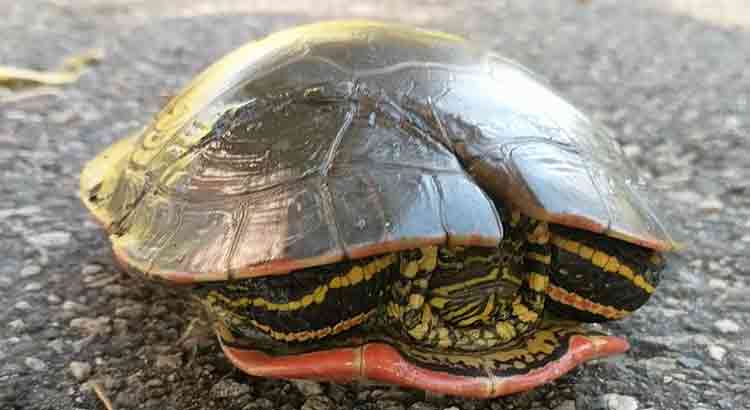Turtles have numerous predators, ranging from cats and dogs, to raccoons and eagles, and even sharks. So their shells must be pretty hard to withstand so many ferocious creatures. But how hard exactly?
On average a turtle’s shell can support pressure up to 200 times its own weight. So a turtle that weighs 5 pounds can withstand a force of up to 1000 pounds. Due to the shell’s shape, certain spots are more vulnerable than others, so while on average a turtle can withstand a lot of pressure, some spots are more fragile than others.
Now, let’s start this article with a practical demonstration, and what better way to show this than a video.
How Much Weight a Turtle Shell Can Withstand
In this video, the turtle shell was able to withstand the direct pressure of 620 pounds. And while this video is entertaining, and an example of how much pressure a turtle shell can withstand, it’s not entirely perfect. But it proves the point.
In the video, you will notice that when the last of the weights are added, the shell doesn’t break immediately. Instead, it breaks right after the weights start to move around. This is because the pressure of the weights was no longer concentrated in a single hard spot, but instead, it started to move around until it reached a soft spot, that couldn’t take all that pressure.
The Soft and Hard Spots of a Shell
The average turtle shell looks something like this.
It has an oval shape, and a ridge in the middle.
The hardest, most durable parts are the top and the ridge, the rest of the shell, while it’s not necessarily soft, it is a vulnerable spot that can break more easily.
The underside of the shell (the plastron), is also considered a soft spot, compared to the rest of the shell, even if it’s not included in this picture, but we will shortly talk about that part as well.
The shell of a turtle is in a lot of ways very comparable to an egg. If you apply pressure randomly on an egg it will easily break, but if you apply pressure on the hard spots, you won’t be able to break it no matter how much you try.
If you didn’t know that about eggs you should check out this video, it helps demonstrate how the hard spots of objects work and it’s really entertaining.
But unlike an egg, turtle shells are a lot tougher, and a lot more complex.
The Parts of a Turtles Shell
While it might seem that a turtle’s shell is one single piece, it is actually made out of 4 different parts that are fused together:
- The Carapace
- The Plastron
- The Bridge
- The Scutes
The Carapace
When you are thinking of a turtles shell you are most likely thinking about the carapace,
The carapace is the upper part of the shell, the part that covers the back of the turtle, and it’s usually in the shape of a dome.
And like most parts of the shell, it’s made out of bones that over time have fused together in order to offer better protection.
The Plastron
The plastron is the least seen part of a turtle’s shell since it covers the belly of the turtle.
When it comes to hardness, the plastron is just as hard as the carapace, but due to its shape, it can’t withstand as much pressure as the carapace. But that’s ok since the role of the plastron is not to protect the turtle from falling objects or animals with powerful bites.
The role of the plastron is to protect the turtle from aquatic predators that might strike from below the turtle. Those predators usually don’t have a very powerful bite since they usually prey on fish that are soft. So the plastron is more than enough to protect the turtle.
The Bridge
The bridge is the part that connects the carapace and the plastron, and it can be found on the sides of a turtle.
The bridge has two purposes, to protect and to connect.
It protects the sides of the turtle, which would otherwise become weak spots, and it connects the carapace and plastron.
Now let’s move to the final part, which is a little bit different from the rest since it’s not exactly part of the shell, but it is. Let me explain.
The Scutes
The scutes are an extra protection layer for the carapace. And unlike the rest of the shell, they are made out of keratin (the same thing our nails are made out of), and over time they will fall, and new ones will grow back.
So the scutes are part of the shell since they grow on it, and from it, but they are not made out of bone, like the rest of the shell.
The main role of the scutes is to prevent small bites, scratches, and daily wear and dare to affect the shell itself.
Final Thoughts
So turtle shells can withstand a lot of pressure, but there are certain spots that can withstand more and some spots that can withstand less. But on average a turtle’s shell can pressure up to 200 times its own weight.
If you are interested in turtle shells and want to find out more about them, or if you liked this article and are getting curious about turtle shells you should check out some of these articles:
- What Are Turtle Shells Made Of ? (with Pictures and Video)
- Can Turtles Live Without Their Shell? (With Pictures and Video)
- Do Turtles Outgrow Their Shells? (With Pictures)
- Turtles Without Shells, do They Exist? (With Pictures and Video)
- How to Get a Turtle Out of Its Shell (Complete Guide)
- Can Turtles Feel Their Shell? (+How Turtles Feel Touch)


